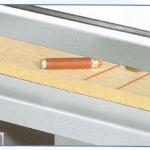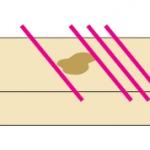Chalk markingManual marking of wood defects, of intersections or for marking quality grades before cutting. Technical principleThe operator visually checks the workpiece in front of him for the presence of unacceptable wood irregularities or assigns the workpiece areas to individual quality grades. The corresponding areas are marked manually with fluorescent chalk using straight lines. After this workpiece has been transferred to the infeed conveyor system of the machine, a sensor (luminescence sensor) determines the marked areas and transfers the position points to the machine control. Depending on the set operating mode, the wood defects are merely cut out in the subsequent work step or the good workpieces are subjected to full optimisation in conjunction with length and quantity data from a parts list. Condition: Length measurement of the raw workpiece.
Chalk markings
Quality markings - when using a luminescence scanner.
Quality markings - when using two luminescence scanners
Related terms
|
CNC machining centres, robots891
Edgebanding, edge processing630
Saws, cutting machines437
Planers, 4-sided moulders188
Routers, shapers, tenoners, profilers179
Drilling, mortising machines135
Presses, clamps, joining machines199
Sanding machines321
Mechanisation, storage, packing technology201
Surface coating152
Production lines127
Heating, drying, waste chopping60
Dust extraction, compressed air, vacuum134
Assembly, worktables15
Lathes29
Tools, sharpening technology91
Equipment, Other machines135



